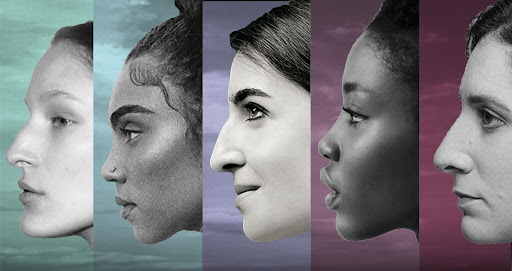Eurocentrism in Beauty Standards
Young people of color continue to feel the effects of the deeply racist legacy of beauty standards.

In a powerful speech about Black beauty at the Black Women in Hollywood Luncheon in 2014, Academy Award-winning actress Lupita Nyong’o spoke candidly about her experience as a young Black girl finally seeing someone who resembled her on television:
Lupita’s moving speech rings true to people of color everywhere, who are discriminated against by the often harsh and singular beauty standards of today. We are inundated with absolute beauty standards over the expanse of social media and television, especially in commercials and advertising; these media forms promote particular “ideal” physical characteristics. The constant emphasis on the beauty of these specific ideal features has reached a point where people are almost unable to differentiate between what they individually find beautiful from what society tells them is beautiful.
Due to the long-lasting effects of colonization and Western imperialism, the “ideal” physical appearance includes generally Eurocentric features: straight and light hair, large blue or green eyes, a small nose, light skin tone, and high cheekbones. These ideals are undoubtedly harmful to people of color who do not fit this Eurocentric concept of beauty, and their racial and ethnic features are rarely represented in the media.
POC (people of color) are thereby often reduced to caricatures and stereotypes based on their physical appearance. On numerous occasions, the ethnic features of POC have been used as trends by white celebrities and influencers, such as excessive tanning to look darker-skinned, wearing locks, and the “fox-eye” makeup trend. To many POC, this is especially insensitive because they have been historically discriminated against for these same features that have now become “trendy,” highlighting how non-Eurocentric features are only considered beautiful when they are displayed on white people.
A clear example of the commodification of ethnic features is displayed in the Kardashians, who have been accused of cultural appropriation and blackface countless times over the years. The family continues to profit off Black womens’ features, despite the numerous times they have been called out for their use of blackface. This perpetuates the false notion that “blackness” (and other features of people of color) can be easily put on and taken off, almost like makeup or a costume.
However, to people of color, these features are a fundamental part of their appearance and commonly mocked and ridiculed, such as the endless jokes about Asian people’s eyes and Black women being told their hairstyles are “unprofessional.” Furthermore, people of color are often easily identified by their ethnic features and targeted through horrific hate crimes.
By only spotlighting white people and their Eurocentric features, we continue to demonstrate to young people of color not only that their natural features are undesirable, but also that they must change their appearances in order to fit into society. While white women, such as the Kardashians, can wear box braids and cornrows and are given full credit for popularizing those hairstyles, Black women straighten their hair in an effort to avoid being bullied at school or being fired from their job.
Centering people of color and their ethnic features is important for young children of color to be able to accept and love their natural appearances, but understanding the white supremacist legacy of beauty standards and changing those beauty standards is imperative.
In an anonymous survey of girls of various ethnicities at Mitty, students were asked questions regarding their opinions and experiences with Eurocentric beauty standards.
The majority of respondents agreed that Eurocentric beauty standards have impacted their idea of beauty standards and their perception of their own beauty to various extents. In a follow-up question about how today’s beauty standards have affected the student personally, one student remarked that they have found themselves unconsciously striving for Eurocentric features because of the lack of representation of people of color in social media, films, and television shows. Another student responded similarly, stating that once they were exposed to this standardized idea of beauty, they began to feel more conscious of their looks and pressured to look a certain way, further affirming the truth that so many young people of color feel they must fit into a specific category for them to be considered attractive.
Today’s beauty standards are definitely more inclusive than they have been previously; there is new and varied representation in the beauty industry, with more people of color put in the spotlight and acknowledged for their features. Still, we cannot stop here. It is more important than ever to have these conversations about systemic racism within beauty standards and the beauty industry and how we must continue to better uplift and affirm people of color.

